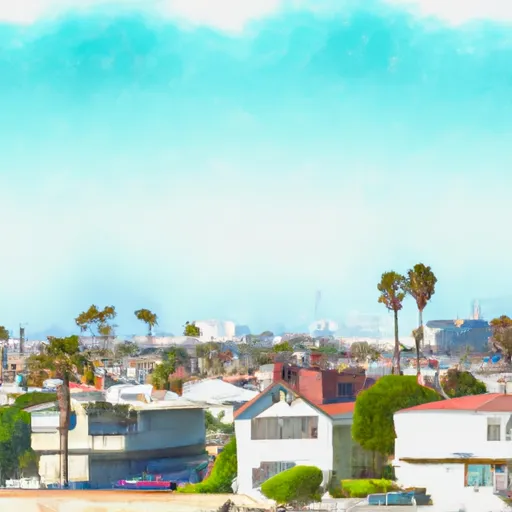-
 Snoflo Premium
Snoflo Premium
Get unlimited access to all our content
With no Ad interruptions! - Start Your Free Trial Login with existing account
Venice
Eden Index
Climate
9.1
•
Recreation
3.9
•
Community
5.7
•
Safeguard
6.4/10

Venice, located on the southern coast of California, is a vibrant and eclectic neighborhood known for its unique blend of canals, beaches, and outdoor activities. The climate in Venice is characterized by mild winters and warm summers. The area experiences a Mediterranean climate, with average temperatures ranging from 55°F (13°C) in winter to 75°F (24°C) in summer. It enjoys abundant sunshine throughout the year.
One of the key features of Venice is its historic canal system, which is reminiscent of its namesake in Italy. These canals contribute to the area's hydrology, as they are interconnected with the Pacific Ocean. Venice Beach is the main attraction, offering a long sandy shoreline and various water sports opportunities, such as surfing, paddleboarding, and swimming.
In addition to its beach activities, Venice also boasts a skate park, basketball courts, and a famous boardwalk lined with street performers, vendors, and artists. Outdoor enthusiasts can also explore the nearby Venice Beach Recreation Center, which offers sports fields, tennis courts, and a pool.
Overall, Venice, California provides a unique coastal experience with its pleasant climate, picturesque canals, and a range of outdoor recreation opportunities for visitors and residents alike.
What is the Eden Index?
The Snoflo Eden Index serves as a comprehensive rating system for regions, evaluating their desirability through a holistic assessment of climate health, outdoor recreation opportunities, and natural disaster risk, acknowledging the profound impact of these factors on livability and well-being.
Climate Health Indicator (CHI): 9.1
Venice receives approximately
342mm of rain per year,
with humidity levels near 58%
and air temperatures averaging around
17°C.
Venice has a plant hardyness factor of
10, meaning
plants and agriculture in this region tend to thrive here all year round.
By considering the ideal temperature range, reliable water supplies, clean air, and stable seasonal rain or snowpacks, the Climate Health Indicator (CHI) underscores the significance of a healthy climate as the foundation for quality living.
A healthy climate is paramount for ensuring a high quality of life and livability in a region, fostering both physical well-being and environmental harmony. This can be characterized by ideal temperatures, reliable access to water supplies, clean air, and consistent seasonal rain or snowpacks.
Weather Forecast
Streamflow Conditions
Ventura-San Gabriel Coastal
Area Rivers
Ventura-San Gabriel Coastal
Snowpack Depths
Ventura-San Gabriel Coastal
Reservoir Storage Capacity
Ventura-San Gabriel Coastal
Groundwater Levels
Recreational Opportunity Index (ROI): 3.9
The Recreational Opportunity Index (ROI) recognizes the value of outdoor recreational options, such as parks, hiking trails, camping sites, and fishing spots, while acknowledging that climate plays a pivotal role in ensuring the comfort and consistency of these experiences.
Access to outdoor recreational opportunities, encompassing activities such as parks, hiking, camping, and fishing, is crucial for overall well-being, and the climate plays a pivotal role in enabling and enhancing these experiences, ensuring that individuals can engage in nature-based activities comfortably and consistently.
Camping Areas
| Campground | Campsites | Reservations | Toilets | Showers | Elevation |
|---|---|---|---|---|---|
| Dockweiler Beach RV | 117 | 45 ft |
Nearby Fishing
Catastrophe Safeguard Index (CSI):
The Catastrophe Safeguard Index (CSI) recognizes that natural disaster risk, encompassing floods, fires, hurricanes, and tornadoes, can drastically affect safety and the overall appeal of an area.
The level of natural disaster risk in a region significantly affects safety and the overall livability, with climate change amplifying these risks by potentially increasing the frequency and intensity of events like floods, fires, hurricanes, and tornadoes, thereby posing substantial challenges to community resilience and well-being.
Community Resilience Indicator (CRI): 5.7
The Community Resilience Indicator (CRI) recognizes that education, healthcare, and socioeconomics are crucial to the well-being of a region. The CRI acknowledges the profound impact of these elements on residents' overall quality of life. By evaluating educational resources, healthcare accessibility, and economic inclusivity, the index captures the essential aspects that contribute to a thriving community, fostering resident satisfaction, equity, and social cohesion.

